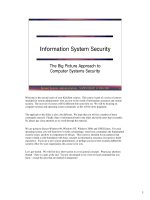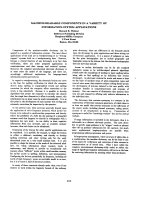Information system ralph CH04
Bạn đang xem bản rút gọn của tài liệu. Xem và tải ngay bản đầy đủ của tài liệu tại đây (719 KB, 56 trang )
Fundamentals of Information
Systems, Fifth Edition
Chapter 4
Telecommunications, the Internet,
Intranets, and Extranets
Principles and Learning Objectives
• A telecommunications system has many
fundamental components that must be carefully
selected and work together effectively to enable
people to meet personal and organization
objectives
– Identify and describe the fundamental components
of a telecommunications system including media and
hardware devices
Fundamentals of Information Systems, Fifth Edition
2
Principles and Learning Objectives
(continued)
– Identify several network types and describe the uses
and limitations of each
– Name three basic processing alternatives for
organizations that require two or more computer
systems and discuss their fundamental features
Fundamentals of Information Systems, Fifth Edition
3
Principles and Learning Objectives
(continued)
• The Internet and the Web provide a wide range of
services, some of which are effective and practical for
use today, others are still evolving, and still others will
fade away from lack of use
– Briefly describe how the Internet works, including
alternatives for connecting to it and the role of Internet
service providers
– Describe how the World Wide Web works and the use
of Web browsers, search engines, and other Web tools
– Identify and briefly describe several applications
associated with the Internet and the Web
Fundamentals of Information Systems, Fifth Edition
4
Principles and Learning Objectives
(continued)
• Because use of the Internet and World Wide Web
is becoming universal in the business environment,
management, service and speed, privacy, and
security issues must continually be addressed and
resolved
– Outline a process and identify tools used to create
Web content
– Define the terms intranet and extranet and discuss
how organizations are using them
– Identify several issues associated with the use of
networks
Fundamentals of Information Systems, Fifth Edition
5
An Overview of Telecommunications
• Telecommunications
– The electronic transmission of signals for
communications
• Telecommunications medium
– Any material substance that carries an electronic
signal to support communications between a
sending and receiving device
Fundamentals of Information Systems, Fifth Edition
6
Fundamentals of Information Systems, Fifth Edition
7
Channel Bandwidth
• The rate at which data is exchanged
• Broadband communications
– A telecommunications system that can exchange
data very quickly
Fundamentals of Information Systems, Fifth Edition
8
Communications Media
• Guided transmission media types
– Many utilities, cities, and organizations are
experimenting with broadband over power lines
(BPL)
• Wireless technologies
– Broadcast of communications in one of three
frequency ranges: microwave, radio, and infrared
– Near Field Communication (NFC)
– Bluetooth
– Ultra wideband (UWB)
– Wi-Fi
Fundamentals of Information Systems, Fifth Edition
9
Fundamentals of Information Systems, Fifth Edition
10
Fundamentals of Information Systems, Fifth Edition
11
Telecommunications Hardware
• Devices include:
– Modems, multiplexers, PBXs and front-end
processors that enable electronic communications to
occur or occur more efficiently
• Switches, bridges, routers and gateways
– Devices for sending packets of data through one or
more networks
Fundamentals of Information Systems, Fifth Edition
12
Fundamentals of Information Systems, Fifth Edition
13
Services
• Digital subscriber line (DSL)
– Telecommunications service that delivers high-speed
Internet access to homes and small businesses over
the existing phone lines
• Asymmetric DSL (ADSL) line
– Does not require an additional phone line and yet
provides “always-on” Internet access
• Voice over Internet Protocol (VoIP)
– Enables voice conversations to be converted into
packets of data that can be sent over a data network
Fundamentals of Information Systems, Fifth Edition
14
Fundamentals of Information Systems, Fifth Edition
15
Fundamentals of Information Systems, Fifth Edition
16
Fundamentals of Information Systems, Fifth Edition
17
Networks and Distributed Processing
• Computer network
– Communications media, devices, and software
needed to connect two or more computer systems
and/or devices
• Network nodes
– Computers and devices on the networks
Fundamentals of Information Systems, Fifth Edition
18
Network Types
• Personal area network (PAN)
– Wireless network that connects information technology
devices within a range of 33 feet or so
• Local area network (LAN)
– Connects computer systems and devices within a small
area, such as an office
• Metropolitan area network (MAN)
– Connects users and their computers in a geographical
area
• Wide area network (WAN)
– Connects large geographic regions
Fundamentals of Information Systems, Fifth Edition
19
Fundamentals of Information Systems, Fifth Edition
20
Distributed Processing
• Centralized processing
– All processing occurs in a single location or facility
• Decentralized processing
– Processing devices are placed at various remote
locations
• Distributed processing
– Computers are placed at remote locations but
connected to each other via a network
Fundamentals of Information Systems, Fifth Edition
21
Client/Server Systems
• Multiple computer platforms are dedicated to
special functions, such as:
– Database management, printing, communications,
and program execution
Fundamentals of Information Systems, Fifth Edition
22
Communications Protocols
• Set of rules that govern the exchange of
information over a communications channel
• Protocols
– Govern several levels of a telecommunications
network
Fundamentals of Information Systems, Fifth Edition
23
Communications Software
• Network operating system (NOS)
– Systems software that controls the computer
systems and devices on a network and allows them
to communicate with each other
• Network management software
– Simplifies the process of updating files and programs
on computers on the network
Fundamentals of Information Systems, Fifth Edition
24
Use and Functioning of the Internet
• Internet
– Collection of interconnected networks, all freely
exchanging information
• ARPANET
– Ancestor of the Internet
– A project started by the U.S. Department of Defense
(DoD) in 1969
• Internet Protocol (IP)
– Enables traffic to be routed from one network to
another as needed
Fundamentals of Information Systems, Fifth Edition
25









